A Short BRCK Interview on CCTV (Video)
At the end of 2013 I sat down with Jiitu Abraham of CCTV to talk about the BRCK. I cover why we built it and who we’re seeing the most interest from as users. Here’s the video.
At the end of 2013 I sat down with Jiitu Abraham of CCTV to talk about the BRCK. I cover why we built it and who we’re seeing the most interest from as users. Here’s the video.
The BRCK is now an independent commercial entity and we’ve started to raise our seed round of investment. This means we’re ramping up and are looking to hire for some specific positions. If you’re hungry to join a team that uses technology to solve real-world problems, and has a fun time while doing so, Tell us why you’d like to join and upload your resume/CV here.
If you join the BRCK team as an engineer, that guy below will be your boss.
Product Development Engineer (Electrical)
BRCK is a rugged wireless router, an internet connectivity device designed in emerging markets for the changing way we access the internet globally. Its job is to extend the edges of the network, and to connect people and sensors where solid infrastructure isn’t found. We think of it as the easiest and most reliable way to get connect, anywhere you are in the world.
Everyone at BRCK comes to work here because we’re building the tools that every day people around the world will use to improve the lives of millions. In other words, in the fight for a better world, we aren’t 007, we’re Q.
BRCK is looking for an electrical designer to join our team in Nairobi, Kenya. The ideal candidate will be a self-starter, with a passion for enabling communication globally. We have very ambitious plans and we are looking for someone that can share our vision, and take the BRCK product to the next level.
The BRCK team, made of world-class mechanical, electrical and software engineers is based in Nairobi, Kenya, fostering a new age of hardware development on the continent. While we would prefer local applicants, international applicants willing to make a transition to Kenya are invited to apply as well.
Skills and Requirements
Optional Skills and Experience
Priority will be given to individuals with a proven track record of pushing the envelope, thinking creatively and a passion for global communication.
Travel
Up to 20% international travel will be required.
Location
This role will be based in the BRCK Design office in Nairobi, Kenya.
Remuneration
Remuneration will be dependent on skills and experience, and we expect to be able to deliver a competitive package.
Background
Ushahidi, BRCK’s parent company, is a non-profit technology company that builds open source software. The word “Ushahidi” means “testimony” in Swahili, and came out of the crowdsourced mapping platform we built during the Kenyan post-election violence in 2008. Our goal is to improve the way information flows in the world, and the BRCK is a natural extension of this. BRCK is a taking the Ushahidi core ethos, and using that to develop best in class communication tool with your help.
Our team tends to think big and rewards creativity and an entrepreneurial attitude. Over the past six years, we have also built the iHub – the tech community hub in Nairobi, the BRCK – a redesign of connectivity for the developing world, and other projects like Savannah Fund, and AfriLabs. Our ethos – we don’t just build products, we solve problems.
I gave a talk at PopTech this year on the BRCK and what I think it means for last mile connectivity in Africa. I believe that digitally connecting people and information is the great challenge of ours.
Here’s the talk itself:
Erik Hersman: BRCK breakthrough from PopTech on Vimeo.
A few weeks ago the #Kenya365 final instameet happened, we had finished the full year of Kenyan instagramming and it was a chance to get everyone together. Mutua Matheka suggested we go to the Kenya Railways Museum, a place I hadn’t been since I was in school. I took my daughters with me, and we had a great time exploring the old trains and marveling at the engineering feats required to create what they did over 100 years ago.
As I was getting ready for my talk at PopTech I started thinking about how those engineers of yesteryear connected the world. Since man had first tamed the horse, we had never moved as quickly or as consistently as when the railroad was created. It was a true changing of the world.
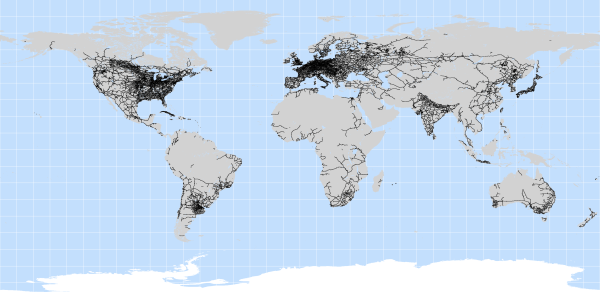
A map of global railway lines
There were many incredible obstacles for the pioneering engineers of that time to overcome.
Kenya’s railway museum reminds of us this rich history of overcoming obstacles with the story of Lt. Col. John Henry Patterson who at the ripe age of 31 was commissioned by the British East Africa Company to help extend the East Africa Railway (EAR) through the Tsavo region on the way from Mombasa to Uganda. It was at the Tsavo river that the unfolding of the great “Man Eaters of Tsavo” lion story unfolds, where two extremely large male lions stopped the railroad’s progress for the better part of a year. Official railway records state 28 died, though 140+ is a more accurate number as it constitutes the non-railway employees taken as well. No matter what the thousands of Indians and African workers did, they couldn’t stop the lions from jumping the thorn bushes, entering tents and braving the fires. Too many nights friends and co-workers were dragged screaming and eaten within hearing distance. It was enough that the workers started to flee in their hundreds.
Now for Col. Patterson, being a stalwart Man of Empire, this was a true crisis. His arrival had coincided with the attacks, so he was to blame by many. He was being disgraced and by any means necessary, he had to get the job done. Fortunately he had served a number of years in India and was an accomplished tiger hunter. 9 months later, Patterson bags both lions in the span of three weeks, changing his story from one of scapegoat and failure to one of a hero. Of course the book he wrote about it didn’t hurt his reputation either – and many of us know this story from the 1996 movie where Val Kilmer plays Col. Patterson in “The Ghost and the Darkness”.
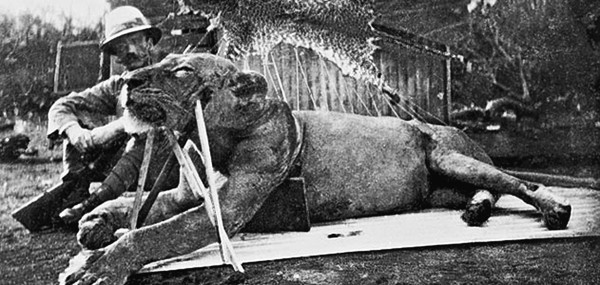
Col. Patterson and one of the man eaters of Tsavo lions
If these pioneers were alive today, what would be their frontier?
Physically connecting people and things was the great challenge of their time. Digitally connecting people and information is the great challenge of ours.
They drove this iron backbone into every continent. It is no coincidence that our new backbones run alongside these same rails and roads. The world over, the engineers of our day are building this internet connectivity through fiberoptic cable into every continent, and Africa is no different.
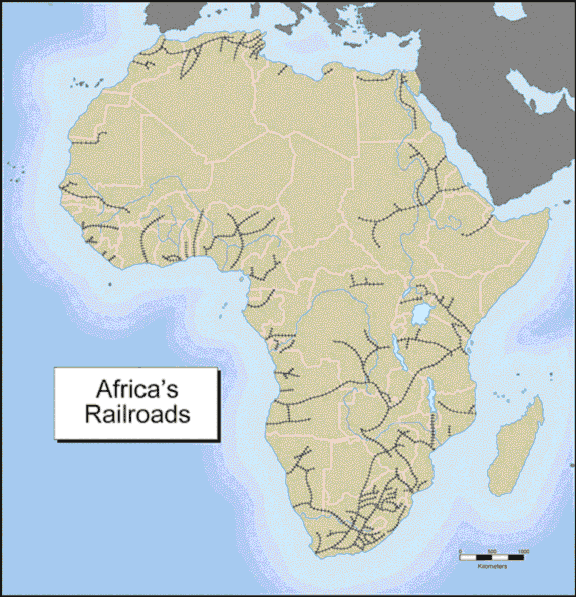
A map of the railway lines in Africa
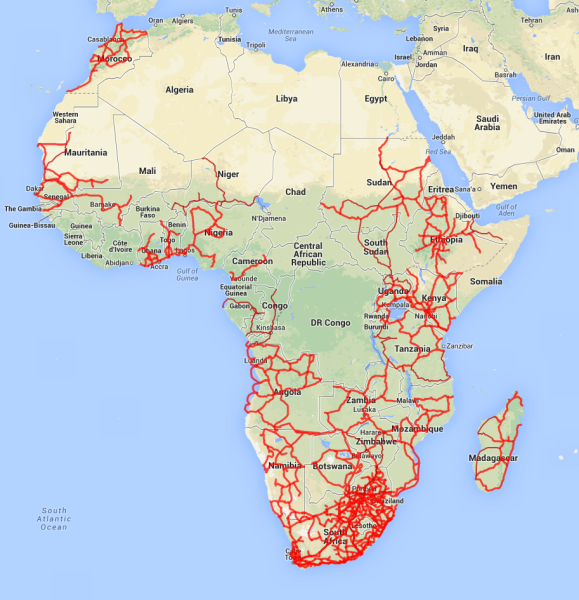
A map of the internet terrestrial fiber optic cables in Africa
(Once again, we all owe a debt to Steve Song for his maps of Internet in Africa, with this terrestrial cable map. A more detailed PDF.)
We have our own obstacles today. For, though we build the internet backbone into Africa, what happens when the rail ends? We have a problem where the infrastructure doesn’t match the connectivity equipment; meaning burnt out servers and routers due to power surges and brown-outs. This caused us to ask, “why are we using the routers and modems designed for London and New York when we live in Nairobi and New Delhi?”
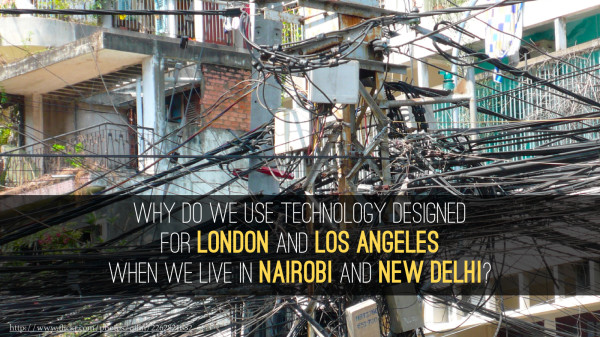
With the BRCK, we’re extending the rail lines of connectivity to the edges of the network.
BRCK provides true last mile connection for Africa and other emerging markets. We designed it for our own needs, in Nairobi. It’s a rugged and simple WiFi device, made for our challenging environment where all of the redundancies of the device for both power and internet connectivity equate to productivity. It connects both people and sensors.
We envision it being used him homes and offices around the continent, by travelers, workers and community health workers in rural areas and by organizations managing everything from water flow sensor to remote power station management on the edges of the grid.
While all of the big technology companies go after “the next big thing”, where they endeavor to stretch the edges of what’s possible with technology, most of the world sits unable to take advantage of the older technology. High-end and brilliant technology is being transplanted from the US and EU to Africa – it is the best technology in the world, it just doesn’t work were we live.
It has become clear that no one else is taking this problem seriously. It’s time for us, as African technologists, to stand up and solve our own problems. To grasp the opportunities. We might even find that the addressable market is much larger and lucrative than our Western counterparts are aware of.
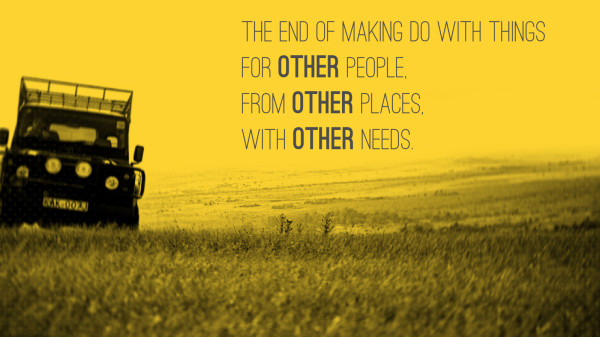
It’s the end of making do with things designed for other people, from other places with other needs. We’re entering a time where good enough is no longer good enough. The BRCK is just one of many new products that are designed for us, by us and meets our needs.
We’re raising a round of investment now for BRCK, you can find out more on Angel List at Angel.co/BRCK. The IP is held by Ushahidi, and the BRCK has spun out as an independent commercial entity in a way that if it does well, so does Ushahidi. We have a strong business strategy, and a fantastic team with which to execute it.
This coming week we are traveling to the far edges of the network as we chase the November 3rd solar eclipse. The BRCK will be stress tested to it’s very limit, for ruggedness, connectivity and reach. If we get the VSat (BGan) connection we’re looking for, then we might be able to live stream the solar eclipse on Nov 3rd from the edges of Lake Turkana to the rest of the world.
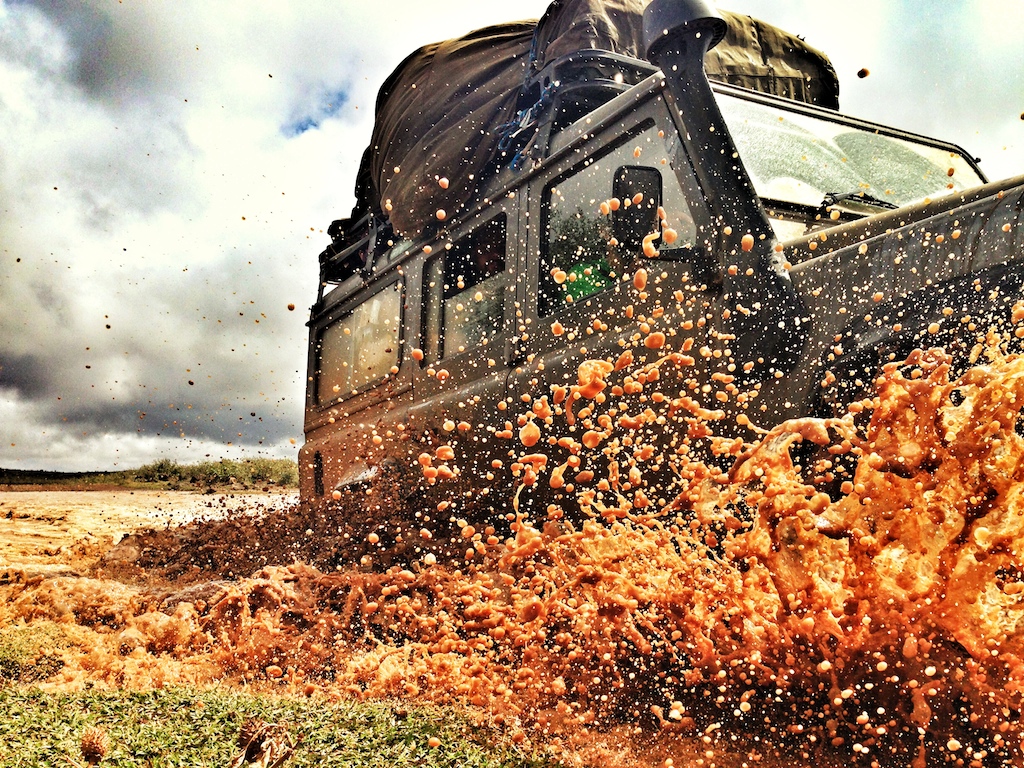
We started out early from Kurungu towards Baragoi, we didn’t have any issues with bandits as there was an increased police presence in the area. It had rained the night before, so the ground for our whole trip was a bit damp, perfect for fast riding. It also created some very waterlogged areas, where we had to get completely soaked up to our waists in the water as we rode through.
Taylor Martyn riding through a deep puddle, north of Maralal, Kenya from WhiteAfrican on Vimeo.
Until we got to the rocks near Maralal, it was a fairly easy ride, then things began to toughen up. One puncture on Taylor’s bike, a quick change, and then off on our way again put us into a rainy Maralal by lunchtime.

We went through some massive puddles along the way, so our boots were completely soaked and we were then able to empty the water from them as we enjoyed some hot chai, chapatis and stew at a local hoteli.

Back into our wet socks and waterlogged boots, and we were off for some rocky, wet and slippery riding down towards Rumuruti – where the tarmac roads begin.
From there it was a quick run down to Gilgil, which we reached by 6:30pm and started for Nairobi, only 1:30 ours away (or so we thought…).
Now, due to the number of spills the bike that I was riding had endured, none of the lights worked, except for the headlight and the right blinker. We put Taylor’s fully functioning bike in front, me in the middle, and the Land Rover behind. The car alternator had gone out the night before, so we didn’t run the car with much electronics all day and the battery seemed to be holding up well.
20 minutes later, just past Naivasha, my headlight went out.
Now, the only place more dangerous than driving on a road in Kenya at night, is the side of the road. But, there we merrily sat, Philip and Reg testing out the electronics and finally realizing that the bulb itself was burnt out. I wondered what a flashlight would look like inside the headlight casing. It turned out to be surprisingly bright, so Fady donated his super expensive and very bright bicycling flashlight to the cause, which turned out to fit perfectly.
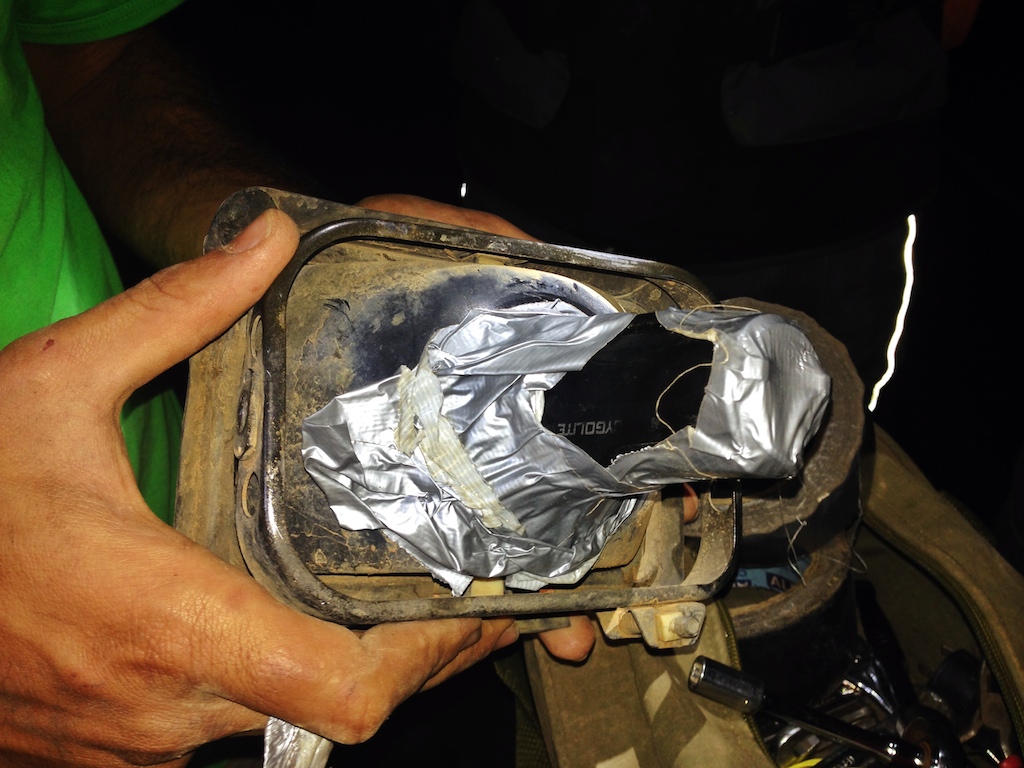
As we duct taped that jua kali light into place, the Land Rover’s batter gave out it’s final death call and the lights went out.
No problem, we put it in reverse and pushed it back down the hill to jump start it. Fortunately, we had a 12,000 mAh Brunton Solo 15 solar charged battery on hand (similar to their new Impel), and we hooked that up to the vehicles lights.
Off we rode into the night, now the truck in front, me on my raggedy old cludged together light bike in the middle, and Taylor riding anchor. It was now very cold, as it gets in the Kenyan highlands during the rains. Then, as we got up towards the top of the escarpment, at the 8,000 feet high level, it started to seriously rain. Now, it’s already hard to see at night on a bike with a headlight pointing up and blinding pilots, with people’s brights deflecting off of the droplets on your visor it becomes even harder. Pop up the visor and you can see again, but the cold and stinging rain now hits you in the face. Better to live with a little pain than die in a collision, so up it went.
We had just passed the Kijabe turnoff when the Land Rover’s second battery died. Fortunately, we were in my territory, as my alma mater RVA was 15 minutes down in Kijabe. We pulled over at a petrol station, called up my old dorm parent Mark Kinzer, and he found a friend who was willing to donate us a fully charged 12v battery for the remainder of the trip. 20 minutes later we had a battery and were moving down the road again.
16 hours after leaving Kurungu, wet, cold and utterly fatigued, we arrived home and well in Nairobi.
Thank god for old friends, good (enough) roads, no bandits and safety through the night drive. A bunch of creative problem solving was needed to get through, as well as stamina and perseverance in the face of the friction that is thrown at you on a trip like this. I can’t tell you how happy I was to get some warm food at home, a warm shower to thaw out my body, and a warm bed to crash collapse into as I went comatose for the night.
Would I do this trip again? Absolutely. In fact, “BRCK Expeditions” are a new thing for us that we’ll continue to do as a company and that we’ll look forward to hearing about from our BRCK users around the world.
I wrote up another blog post on my personal blog today about some of the things I learned about our team. They are:
Yesterday we took off from Sibiloi towards Loiyangalani and then on towards South Horr. Besides a tire puncture along the way for the car, it was nice and easy. We were able to stop and talk about the eclipse with a few eclipse chasers from Spain and they said they got a somewhat clear picture of it, with just a small bit of cloud cover. There were so many vehicles leaving the north, that big clouds of dust covered us and made us look like brown powdered humans.
While stopped on the side of the road, about 100 Kilometers from Loiyangalani we could get a very weak Edge mobile phone signal. Enough to send some tweets and call people, but no real media uploads. We spent some time with the Wilson amplification antennas, but didn’t have too much luck because we didn’t know the exact location of the tower from where we were. It’s a great piece of equipment though, one we love to break out and use with the Yaggi antenna from the top of the Land Rover.
Fady got his second motorcycle riding lesson. Again, on some of the worst roads that Africa can throw at you… amazing really. He did it all with speed and grace, and just a single tip-over.
We overnighted at the Swanepoels again, where we talked about the route possibilities. Massive rains have cut off a lot of the roads. Our 3 choices were: Marsabit (safe, long), Korr (not possible due to rains) and Baragoi (security issues, but short). We were heavily cautioned about Baragoi and Maralal, so opted for Marsabit and set off at 5:30am.
Today’s trip started off with eating a lot of flying ants. They flew so thick as we rode that it was like riding in a snow storm, except with wings. I got the all in my goggles and helmet, light and other gear. Everyone was covered in flying ants when we stopped 30 minutes later.

2 hours later found us sitting by the side of the road wondering how we were going to unstick a very stuck Land Rover. We had slipped and slid our way through, and Fady earned his “wet” riding badge with honors.
4-hours later, we were still stuck, after trying every trick we knew. I even tried something very stupid, and paid for it, trying to pull with my Suzuki DR650 and burning out the clutch plate. Now my motorcycle isn’t running and I have to leave it in South Horr with my friend to get it back down to Nairobi in a few weeks. This, I’m not happy about, but I should have thought through what I was trying to do.

A Landcruiser came through in a few hours and helped pull us out. 2 riders and 2 motorcycles sat by the side of the road while the others tried to push through. However, a new lake had formed on the way to Kargi and Marsabit, so they turned around and came back. A Land Rover had showed up, and we hired him to take my motorcycle back to South Horr.

So, now we sit in the same place that we sat yesterday at the same time.
Tomorrow we shoot off towards Baragoi. Though there have been bandits on the road, we’ve heard from another friend who went that way today that there is a lot of extra security on it and that they’ve just graded the road. With a lot of luck, we can make it to Naivasha and onto Nairobi by tomorrow night.

6am rolled around and we all jumped up, hungry, but rested. Sunrise was amazing. A beautiful color that shed some light on where we actually were. As I type this, there is a warthog about 20m away to my left, while both greater and lesser flamingos, along with some kind of wild goose, feed 20m away in front in Lake Turkana.
Sibiloi is distant and harsh. It’s a forgotten mixture of austere beauty, heat, wind and silence – that though it isn’t welcoming, is still a joy to be at.
I can think of no reason why 200-300 people would come here, except for the rare hybrid eclipse that we’re about to see tonight.
We swore we had driven through trees, but there were none around, not within 10 miles. This should be an object lesson in the illusions that one sees when riding and driving after so many hours on the road at night. It also became apparent that we’d have to lose any sense of privacy when it came time to find a restroom. It’s a good thing that this is not a mixed group. 🙂
All morning we’ve been working on getting a couple things tested:
1. Internet, we’ve got a BGAN terminal for satellite data connectivity provided to us by Indigo Telecom in Nairobi. They rent them out to people everywhere in the region, and have been great to work with. That’s working nicely, and hopefully we’ll get the eclipse livestreamed at brk.com/eclipse.
2. Mobile phone signal, Wilson has provided us with some long range amplification antennas. We tested them in Kurungu, where we turned a weak Edge signal from Safaricom that couldn’t transmit any data into a very strong Edge connection that was usable. They gave us a couple to test out, and we’ll do so again on the road back to Loiyangalane, from the a hill about 20-30km away. We don’t have a good line of sight from where we are to the tower in Loiyangalane from Sibiloi, so can’t get a signal here.
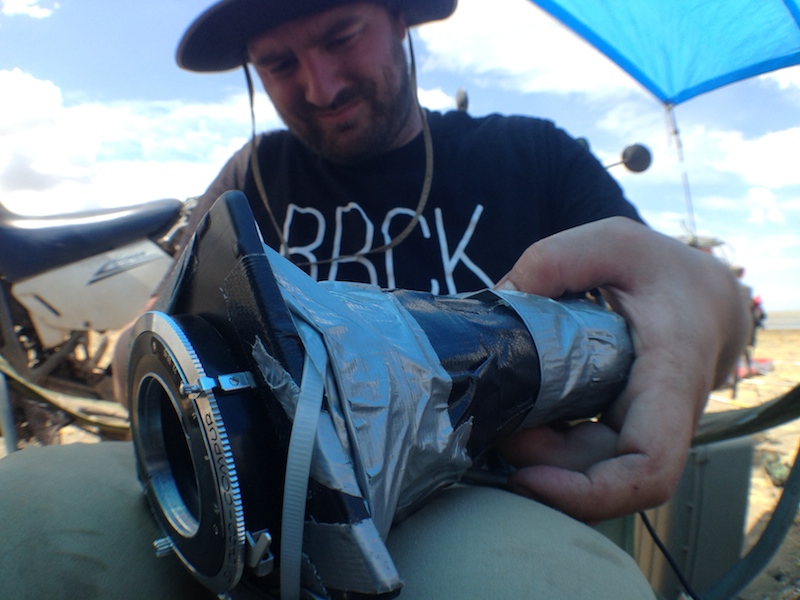
3. Camera setup for the Eclipse. What we’ll be streaming with is a Frankenstein-like beast, that’s cobbled together from a web cam, toilet paper roll and a Schneider large format lens, all held together by gaffer tape. It’s really amazing, the fact that the team has such a mix of camera and digital know-how to pull this off by Jon and Philip, was great to watch.
4. Power for the computers and BGAN. There’s a lot of “hack it together” knowledge on the team, and between Reg and Philip they were able to jimmy rig some solar to car battery to inverter to hacked together power plug. some people will tell you that this is “real field constructed power distribution” – we all know it’s a jua kali rig job.
While all that is being set up, it’s great to see the BRCKs humming along quite nicely. The BRCK flag now waves above the Land Rover at Camp Jawbone (named after the zebra jawbone we found when setting up camp last night).
Now we’re waiting for 5pm to get the livestream rolling. Crossing our fingers now for a cloudless sky tonight.
Update: It’s 5 minutes to the eclipse, we just had a massive sand storm and rain storm pass through. barely getting connection and a lot of clouds. Probably can’t stream, so will try to upload images.
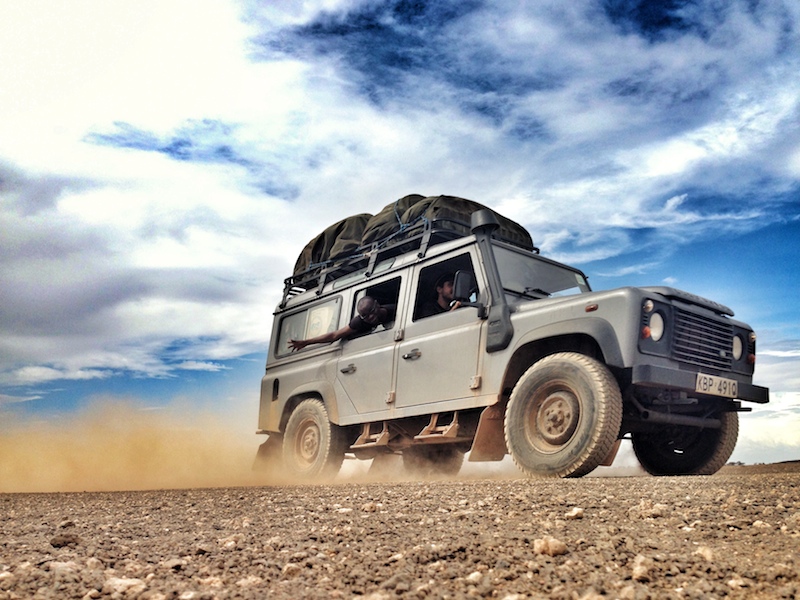
Day 3 started a little late as we had to fix Taylor’s front forks, which had met with an untimely collision with some mud and sand the day before. He rode about 100 kilometers on a skewed front tire, which just made the sand at night a bit harder, so it was a miracle that he didn’t go over again.
After an amazing breakfast from the Swanepoels, we made great time on smooth roads from Kurungu to Loiyangalane, this day resolved to stop and eat lunch, refill the water and relax for 30 minutes before we did the last run to Sibiloi. Now, the road to Sibiloi has always been an adventure, and it didn’t disappoint us… It’s about 125km from Loiyangalane to Sibiloi, and it’s full of massive boulders, though those had been cleared and a beautiful road put up the incline of the escarpment.
Again, we made good time for the first half of it. Then, Philip took a bit of a tumble on the open sand flats. There’s a real tricky bit of riding where the sand becomes talcum under you with little warning. He hit a patch and as he went down hit his hand on a rock. A bit of blunt trauma treatment later it was decided that he couldn’t ride any longer. This left us in a bit of a bind as no others in the vehicle knew how to ride a motorcycle.
We were about to hoise the large Honda 650 XLR onto a passing Kenya Wildlife Services vehicle. Right before we lifted it, Fady decided he’d give it a try…
Fady is some kind of superman. He learned to ride a motorcycle on the sand flats at 5:30pm and rode for the next 3 hours into the night through the African bush. It was quite amazing really, I’ve never witnessed anything like this before, and know that I could never have done the same. Your first 3 hours EVER of riding a motorcycle are done in some of the harshest terrain – at NIGHT!?
Needless to say, we’ll be providing Fady with a certificate of excellence. (special note from Fady: “Smurfy don’t kill me”)
We were the final vehicles into Sibiloi National Park last night. It was about 8:30pm and we were completely exhausted. Now, you’re normally not allowed to bring motorcycles into any national park in Kenya. However, this time the warden made an exception, as long we agreed to ride straight to the camp and not ride them again until we left. I can’t tell you how good that made all of us feel and we owe the KWS a huge note of thanks for taking so much good care of us last night. In particular, a gentleman by the name of Sode was exceptional and I just wish all government employees were as pleasant and helpful.
Once past the gate, we drove down a road until we literally drove into Lake Turkana. After we backed out of the water, the KWS guys showed up again, along with Andrew Nightengale – someone I know from staying at his farm with my family a few years ago. He pointed us towards a place right along the lake a few hundred meters away.
Once again, exhausted at the end of another African bush night drive, after a full day on the road, we set up our tents. A few bowls of my wife’s chili later (promptly announced as the “best food ever” by everyone), with some Dickel Bourbon whiskey as a chaser, we collapsed into our tents and slept like the dead.
Well, yesterday was exhausting. 14-hours of driving and riding later and we pulled into Kurungu.

We roared off at 6:30am from Nanyuki, only to have a puncture an hour later, that cost us almost 1.5 hours due to complications. This had a ripple effect that meant getting to Laisamis at 1pm. Rain hit us in Laisamis, and softened up the soil on our way to Ngurunit. That slowed us down a great deal.
We had about an hour left of daylight by the time we hit Ngurunit, some of the most amazing scenery you’ll see in Kenya, but we couldn’t stop for pictures as we had to use all the daylight possible for driving.
Night driving is hard anywhere, but it’s harder when you’re in mud, deep talcum-powder sand and rocks. We had all of that and we did it for 3 hours in the dark. There were a couple layovers, but thankfully we were going at a slow enough speed that no one was injured – and no bikes were put in too bad of a condition.
There were times where we got so fatigued, and then were staring at that single beam of light on a bumpy dirt road, so that the hard angles all looked like a gully or hole. Made for slow, stressful and hard riding.
Here’s where I get to say thank God that I grew up here in Kenya since I was a little boy, with the Swanepoel family (originally from South Africa). Father and son live up north here, and they welcomed us late at night with a warm meal and a roof and beds.
This morning we woke up to hot coffee, 800mg of Ibuprofen, bruises and soar arms/shoulders. Yesterday was hard. Today is harder. We’ve got a fairly easy go of it to the lake, then it gets hot and hard as we ride alongside the lake to Loiyangalane. After that, it’s even worse, so we here, with boulders. We’re about 30 minutes behind schedule, but I think we’ll make it okay, and hopefully in the daylight.
This morning finds the BRCK team in Nanyuki, only about 3-4 hours outside of Nairobi. The same place we were supposed to be having breakfast yesterday, not today. A rather inauspicious start happened about 30 kilometers into the trip when the Land Rover decided it was going to have some cooling problems.
After two hours of working on solutions, we realized that this Land Rover just wasn’t going to make it. Too bad, as it had two tanks and better range than most. Fortunately, Fady Rostom (of Ark/Bonk) is traveling with us. He offered up his Land Rover 110, and we quickly got in touch with a mechanic in Nairobi who put a roof rack on his vehicle in about 30 minutes.

1pm found us with all equipment unloaded near Thika town, on the side of the road. 5 tires were changed from one Land Rover to the other, and we repacked the new vehicle. Finally, we were on our way (again)!
In hindsight, what was extremely disappointing at the time ended up happening about the best time we’d like to have seen a problem like that develop – in the beginning of the trip near the big city, where we could still make a change.
We got into Nanyuki in the evening, after a nice cold rain hit us, much to the chagrin of those of us on motorcycles with only mesh jackets on. Taylor had his full rain gear (who we had been making fun of earlier due to the heat), and while we froze he rode in relative comfort. Dinner was at Barnies, and then a shack that makes and sells the best cheeses that we’ve ever found in Kenya, called Silent Valley Cheese. 6 kilos of cheese later we found a house owned by a friend to sleep at for the night.
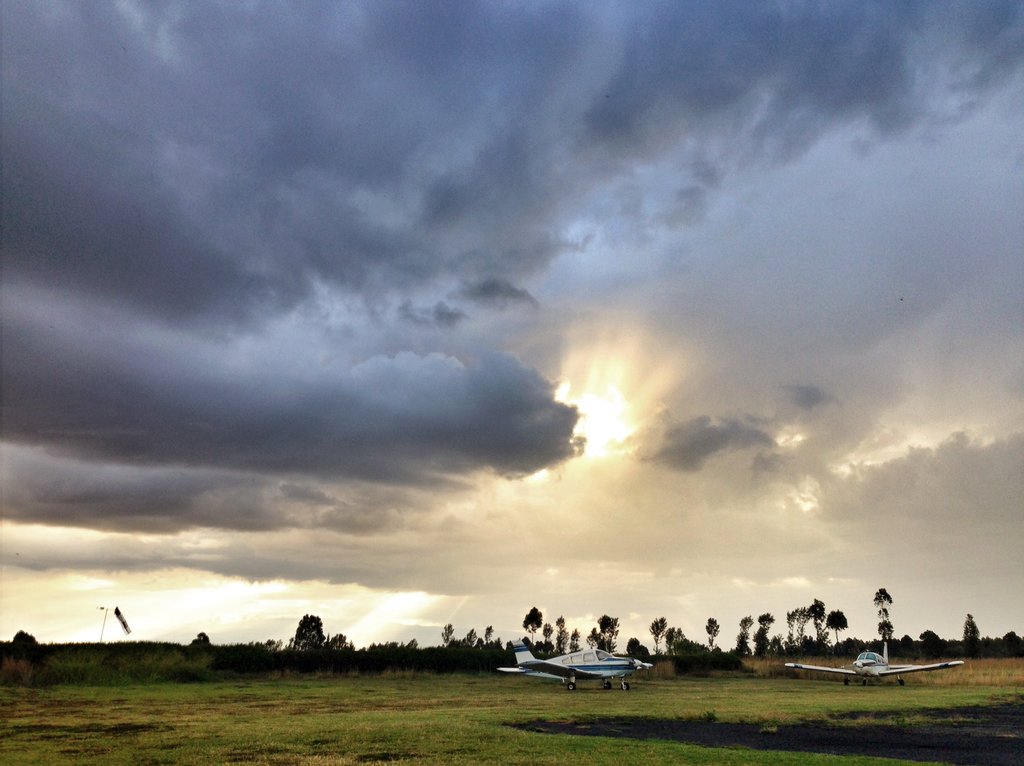
This changes the stages of our trip, and now we’re very glad that we built in a buffer day for the drive up to Lake Turkana. We’ll still arrive the day before the eclipse (Oct 2), but in the evening instead of the morning. Our route now entails an early morning offing from Nanyuki, final fill up of fuel in Isiolo, then off road around Laisamis towards Ngurunit and on to Kurungu and Soth Horr for the night.
This next section along the edge of the Matthews mountain range is one of the most scenic places in Kenya. We’ll stop along the way for some pictures, and then get into Kurungu in time to test the Wilson amplification antennas. The point of these amp antennas is to extend the range one can be from the mobile phone tower to get internet connectivity. We’ve used one before in Lamu, now we’re trying it in the bush, and with the BRCK.